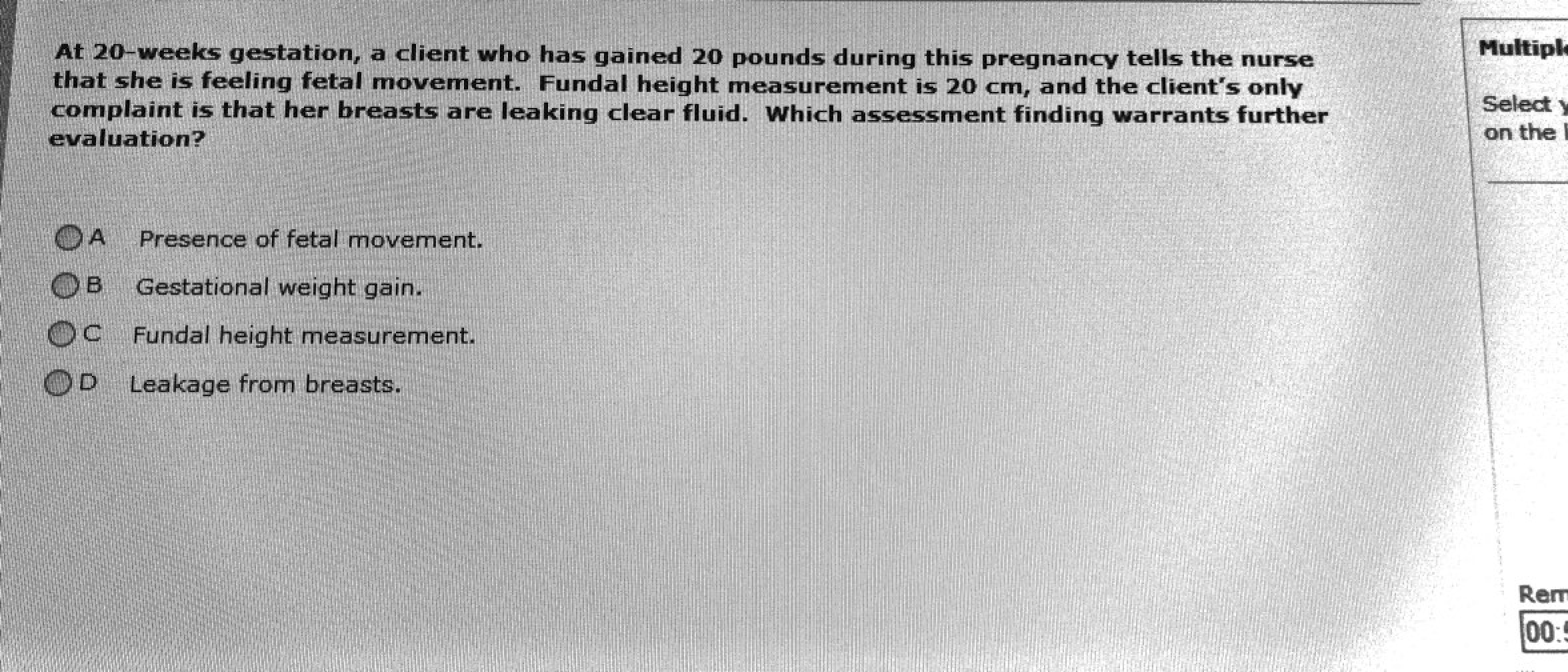NUR 634 FINAL EXAM-ALREADY GRADED A
Document Content and Description Below
NUR 634 Final Exam Grand Canyon You are examining an elderly man and notice the following: Decreased vibration sense in the feet and ankles, diminished gag reflex, right patellar reflex less than the ... left, and diminished abdominal reflexes. Which of these is abnormal? A 68-year-old retired farmer presents to your office for evaluation of a skin lesion. On the right temporal area of the forehead, you see a flattened papule the same color as his skin, covered by a dry scale that is round and feels hard. He has several more of these scattered on the forehead, arms, and legs. Based on this description, what is your most likely diagnosis? A 14-year-old junior high school student is brought in by his mother and father because he seems to be developing breasts. The mother is upset because she read on the Internet that smoking marijuana leads to breast enlargement in males. The young man adamantly denies using any tobacco, alcohol, or drugs. He has recently noticed changes in his penis, testicles, and pubic hair pattern. Otherwise, his past medical history is unremarkable. His parents are both in good health. He has two older brothers who never had this problem. On examination, you see a mildly overweight teenager with enlarged breast tissue that is slightly tender on both sides. Otherwise his examination is normal. He is agreeable to taking a drug test. What is the most likely cause of his gynecomastia? A 17-year-old female presents to your office, complaining of a clear discharge from her right breast for 2 months. She states that she noticed it when she and her boyfriend were “messing around” and he squeezed her nipple. She continues to have this discharge anytime she squeezes that nipple. She denies any trauma to her breasts. Her past medical history is unremarkable. She denies any pregnancies. Both of her parents are healthy. She denies using tobacco or illegal drugs and drinks three to four beers a week. On examination, her breasts are symmetric with no skin changes. You are able to express clear discharge from her right nipple. You feel no discrete masses and her axillae are normal. The remainder of her heart, lung, abdominal, and pelvic examinations are unremarkable. A urine pregnancy test is negative. What cause of nipple discharge is the most likely in her circumstance? A 26-year-old flight attendant presents in for a third trimester prenatal visit. She has had prenatal care since her sixth week of pregnancy. She has no complaints today and her prenatal course has been unremarkable. Today her blood pressure and weight gain are appropriate, and her urine is unremarkable. You have a first-year medical student shadowing you, so you ask the student to get Doptones and measure the patient’s uterus in centimeters. The nurse practitioner student promptly reports fetal heart tones of 140, but he is having difficulty obtaining the correct measurement. He knows one end of the tape goes over the uterine fundus. From what inferior anatomic position should the tape be placed? A 58-year-old gardener presents to your office for evaluation of a new lesion on her upper chest. The lesion appears to be “stuck on” and is oval, brown, and slightly elevated with a flat surface. It has a rough, wart like texture on palpation. Based on this description, what is your most likely diagnosis? Which of the following represents age-related changes in the lungs? A 15-month-old is brought to you for a fever of 38.6 degrees Celsius and fussiness. The ear examination is as follows: external ear, normal appearance and no tenderness with manipulation; canal, normal diameter without evidence of inflammation; tympanic membrane, bulging, erythematous, and opaque. Insufflation is deferred due to pain. What is the most likely condition here? A 28-year-old musician presents to your clinic, complaining of a “spot” on his penis. He states his partner noticed it 2 days ago and it hasn’t gone away. He says it doesn’t hurt. He has had no burning with urination and no pain during intercourse. He has had several partners in the last year and uses condoms occasionally. His past medical history consists of nongonococcal urethritis from Chlamydia and prostatitis. He denies any surgeries. He smokes two packs of cigarettes a day, drinks a case of beer a week, and smokes marijuana and occasionally crack. He has injected IV drugs before but not in the last few years. He is single and currently unemployed. His mother has rheumatoid arthritis, and he doesn’t know anything about his father. On examination, you see a young man appearing deconditioned but pleasant. His vital signs are unremarkable. On visualization of his penis, there is a 6-mm red, oval ulcer with an indurated base just proximal to the corona. There is no prepuce because of neonatal circumcision. On palpation, the ulcer is nontender. In the inguinal region, there is nontender lymphadenopathy. What disorder of the penis is most likely the diagnosis? A 22-year-old law student presents to your office complaining of severe abdominal pain radiating to his back. He states it began last night after hours of heavy drinking. He has had abdominal pain and vomiting in the past after drinking but never as bad as this. He cannot keep any food or water down, and these symptoms have been going on for almost 12 hours. He has had no recent illnesses or injuries. His past medical history is unremarkable. He denies smoking or using illegal drugs but admits to drinking 6 to 10 beers per weekend night. He admits that last night he drank something like 14 drinks. On examination you find a young male appearing his stated age in some distress. He is leaning over on the examination table and holding his abdomen with his arms. His blood pressure is 90/60 and his pulse is 120. He is afebrile. His abdominal examination reveals normal bowel sounds, but he is very tender in the left upper quadrant and epigastric area. He has no Murphy’s sign or tenderness in the right lower quadrant. The remainder of his abdominal examination is normal. His rectal, prostate, penile, and testicular examinations are normal. He has no inguinal hernias or tenderness with that examination. Blood work is pending. What etiology of abdominal pain is most likely causing his symptoms? A 32-year-old white female presents to your clinic complaining of overwhelming sadness. She says for the past 2 months she has had crying episodes, difficulty sleeping, and problems with overeating. She says she used to go out with her friends from work, but now she just wants to go home and be by herself. She also thinks that her work productivity has been dropping because she just is too tired to care or concentrate. She denies any feelings of guilt or any suicidal ideation. She states that she has never felt this way in the past. She denies any recent illness or injuries. Her past medical history consists of an appendectomy when she was a teenager; otherwise, she has been healthy. She is single and works as a clerk in a medical office. She denies tobacco, alcohol, or illegal drug use. Her mother has high blood pressure and her father has had a history of mental illness. On examination, you see a woman appearing her stated age who seems quite sad. Her facial expression does not change while you talk to her and she makes little eye contact. She speaks so softly you cannot always understand her. Her thought processes and content seem unremarkable. What type of mood disorder do you think is most likely? A young Hispanic mother brings in her 2-month-old son. She is upset because her neighbors have threatened to call the Child Protective Agency because they think his birthmark is a bruise. Her son was the product of an uneventful pregnancy and spontaneous vaginal delivery. On examination, you see a large, smooth-bordered bluish mark on his buttock and lower back. Otherwise his examination is unremarkable. What form of birthmark is this likely to be? A 15-year-old high school sophomore presents to the clinic for evaluation of a 3-week history of sneezing; itchy, watery eyes; clear nasal discharge; ear pain; and nonproductive cough. Which is the most likely pathologic process? A 22-year-old clerk, primigravida, presents to your office for a prenatal visit. She is in her second trimester and has had prenatal care since she was 8 weeks pregnant. Her only complaint is that she has a new brownish line straight down her abdomen. On examination her vital signs are unremarkable. Her urine has no protein, glucose, or leukocytes. With a doppler the fetal heart rate is 140, and her uterus is palpated to the umbilicus. Today you are sending her for congenital abnormality screening and setting up an ultrasound. What physical finding is responsible for her new “brown line”? Mr. Q. is a 45-year-old salesman who presents to your office for evaluation of fatigue. He has come to the office many times in the past with a variety of injuries, and you suspect that he has a problem with alcohol. Which one of the following questions will be most helpful in diagnosing this problem? A 35-year-old bus driver presents to your office for a prenatal visit. She is approximately 28 weeks pregnant and has had no complications. She is complaining only of heartburn and has had no fatigue, headaches, leg swelling, contractions, leakage of fluid, or bleeding. On examination, her blood pressure is 142/92 and her urine shows no glucose, protein, or leukocytes. Her weight gain is appropriate, with no large recent increases. Fetal tones are 140 and her uterus measures 32 cm from the pubic bone. Looking back through her chart, you see her prenatal blood pressure was 120/70 and her blood pressures during the first 20 weeks were usually 120 to 130/70 to 80. What type of blood pressure is this? A 40-year-old mother of two presents to your office for consultation. She is interested in knowing what her relative risks are for developing breast cancer. She is concerned because her sister had unilateral breast cancer 6 years ago at age 38. The patient reports on her history that she began having periods at age 11 and has been fairly regular ever since, except during her two pregnancies. Her first child arrived when she was 26 and her second at age 28. Otherwise, she has had no health problems. Her father has high blood pressure. Her mother had unilateral breast cancer in her 70s. The patient denies tobacco, alcohol, or drug use. She is a family law attorney and is married. Her examination is essentially unremarkable. Which risk factor of her personal and family history most puts her in danger of getting breast cancer? When should a woman conduct breast self-examination with respect to her menses? Jacob, a 33-year-old construction worker, complains of a “lump on his back” over his scapula. It has been there for about a year and is getting larger. He says his wife has been able to squeeze out a cheesy-textured substance on occasion. He worries this may be cancer. When gently pinched from the side, a prominent dimple forms in the middle of the mass. What is most likely? You have been unable to hear normal S2 splitting in children up to this point. What technique will maximize your chances of hearing this phenomenon? A grandmother brings her 13-year-old grandson to you for evaluation. She noticed last week when he took off his shirt that his breastbone seemed collapsed. He seems embarrassed and tells you that it has been that way for quite some time. He states he has no symptoms from it, and he just tries not to take off his shirt in front of anyone. He denies any shortness of breath, chest pain, or lightheadedness on exertion. His past medical history is unremarkable. He is in sixth grade and just moved in with his grandmother after his father was deployed to the Middle East. His mother died several years ago in a car accident. He states that he does not smoke and has never touched alcohol. On examination, you see a teenage boy appearing his stated age. On visual examination, of his chest you see that the lower portion of the sternum is depressed. Auscultation of the lungs and heart are unremarkable.What disorder of the thorax best describes your findings? Ray works a physical job and notes pain when he attempts to lift his arm over his head. When you move the shoulder passively, he has full range of motion without pain and there is no gross swelling or tenderness. What type of joint disease does this most likely represent? Blood pressure abnormalities found more commonly in Western elderly include which of the following? A 22-year-old architecture major presents to your office complaining of severe burning with urination, a fever of 101 degrees, and aching all over. She denies any upper respiratory, gastrointestinal, cardiac, or pulmonary symptoms. Her past medical history consists of severe acne. She is currently on an oral contraceptive. She has had no pregnancies or surgeries. She reports one new partner within the last month. She does not smoke but does drink occasionally. Her parents are both in good health. On examination, you see a young woman appearing slightly ill. Her temperature is 100.3 and her pulse and blood pressure are unremarkable. Her head, ears, eyes, nose, throat, cardiac, pulmonary, and abdominal examinations are unremarkable. Palpation of the inguinal nodes shows lymphadenopathy bilaterally. On visualization of the perineum, there are more than 10 shallow ulcers along each side of the vulva. Speculum and bimanual examination are unremarkable for findings, although she is very tender at the introitus. Urine analysis has some white blood cells but no red blood cells or bacteria. Her urine pregnancy test is negative. Which disorder of the vulva is most likely in this case? Adam is a very successful 15-year-old student and athlete. His mother brings him in today because he no longer studies, works out, or sees his friends. This has gone on for a month and a half. When you speak with him alone in the room, he states it “would be better if I was not here.” What would you do next? A 73-year-old nurse presents to your office for evaluation of new onset of pill rolling tremors. She is not on any medications and does not take herbs or supplements. She has no chronic medical conditions. She does not smoke or drink alcohol. She walks into the examination room with slow movements and shuffling steps. She has decreased facial mobility and a blunt expression, without any changes in hair distribution on her face. Based on this description, what is the most likely reason for the patient’s symptoms? Two weeks ago, Mary started a job which requires carrying 40-pound buckets. She presents with elbow pain worse on the right. On examination, it hurts her elbows to dorsiflex her hands against resistance when her palms face the floor. What condition does she have? A 29-year-old computer programmer presents to your office for evaluation of a headache. The tightening sensation is located all over the head and is of moderate intensity. It used to last minutes, but this time it has lasted for 5 days. He denies photophobia and nausea. He spends several hours each day at a computer monitor/keyboard. He has tried over-the-counter medication; it has dulled the pain but not taken it away. Based on this description, what is your most likely diagnosis? An 81 year old patient complains of shortness of breath for the past few days. On examination, you note late inspiratory crackles in the lower third of the chest and bilateral pedal edema that were not present a week ago. What is the most likely explanation for these? A high school soccer player “blew out his knee” when the opposing goalie’s head and shoulder struck his flexed knee while the goalie was diving for the ball. All of the following structures were involved in some way in his injury, but which of the following is actually an extra-articular structure? A woman in her 30th week has a cervical length estimated at 1 cm. Should you be concerned? A young woman presents in for a routine wellness examination. You notice that her vaginal walls have deep rugae and are slightly bluish in color. She also has a thicker white discharge. What should you suspect? Ms. Whiting is a 68-year-old who presents in for her usual follow-up visit. You notice a few flat, red, and purple lesions, about 6 centimeters in diameter, on the ulnar aspect of her forearms but nowhere else. She doesn’t mention them. They are tender when you examine them. What should you do? A 58-year-old man presents to your office complaining of bilateral back pain that now awakens him at night. This has been steadily increasing for the past 2 months. Which one of the following is the most reassuring to you as a clinician in this patient with back pain? A 19-year-old childcare worker presents to you for her first prenatal visit. She cannot remember when her last period was but thinks it was between 2 and 5 months ago. When she began gaining weight and feeling “something” moving down there, she did a home pregnancy test and it was positive. She states she felt the movement about a week ago. She has had no nausea, vomiting, fatigue, or fevers. Her past medical history is remarkable only for irregular periods. She has been dating the same young man for a year. She says they were not using condoms. On examination, you see an overweight young lady appearing her stated age. Her head, eyes, ears, nose, throat, neck, thyroid, cardiac, and pulmonary examinations are unremarkable. Her abdomen is nontender, with normal bowel sounds, and the gravid uterus is palpated to the level of the umbilicus. Fetal tones are easily found with doppler, and, with the fetoscope, a faint heart rate of 140 is heard. By speculum examination, the cervix is bluish, and by bimanual examination, the cervix is soft. Results of Pap smear, cultures, and blood work are pending. You give the patient her due date and how far along she is based on your clinical findings. An OB ultrasound to confirm her dates is ordered. With only the clinical examination, how many weeks pregnant did you tell this patient she is? When you enter your patient’s examination room, his wife is waiting there with him. Which of the following is most appropriate? Mrs. Buckley is a 75-year-old widow who wants you to look at her teeth because over the past 2 weeks she has had right-sided jaw pain when eating. It does not occur otherwise. She also has had a headache. Which of the following should be considered? Glaucoma is the leading cause of blindness in African-Americans and the second leading cause of blindness overall. What features would be noted on funduscopic examination? A 26-year-old telephone operator presents to your office for her first prenatal visit. This is her first pregnancy. Her last period was about 2 months ago. She has no current complaints. She is eating healthily, taking vitamins, and exercising. She has a past medical history of an appendectomy as a teenager. Her mother had three children vaginally with no complications. On examination, she appears healthy and her vital signs are unremarkable. Her head, eyes, ears, nose, throat, thyroid, cardiac, pulmonary, and abdominal examinations are also unremarkable. By speculum examination, her cervix appears bluish in color and highly vascular. A bimanual examination reveals a soft cervix and a 12-week-sized uterus. No masses are felt in either adnexal area. Results of her Pap, cultures, and blood work are pending. What clinical sign is responsible for her blue, highly vascular cervix? 40. You are having trouble examining the abdomen of a school-aged child due to ticklishness. What should you do? A 29-year-old married computer programmer presents to your clinic, complaining of “something strange” going on in his scrotum. Last month while he was doing his testicular self-examination, he felt a lump in his left testis. He waited a month and felt the area again, but the lump was still there. He has had some aching in his left testis but denies any pain with urination or sexual intercourse. He denies any fever, malaise, or night sweats. His past medical history consists of groin surgery when he was a baby and a tonsillectomy as a teenager. He eats a healthy diet and works out at the gym five times a week. He denies any tobacco or illegal drugs and drinks alcohol occasionally. His parents are both healthy. On examination, you see a muscular, healthy, young-appearing man with unremarkable vital signs. On visualization, the penis is circumcised with no lesions; there is a scar in his right inguinal region. There is no lymphadenopathy. Palpation of his scrotum is unremarkable on the right but indicates a large mass on the left. Placing a finger through the inguinal ring on the right, you have the patient bear down. Nothing is felt. You attempt to place your finger through the left inguinal ring but cannot get above the mass. On rectal examination, his prostate is unremarkable. What disorder of the testes is most likely the diagnosis? Mr. R. is a 92-year-old retired teacher who presents to your clinic accompanied by her daughter. You ask Mrs. R. why she came to your clinic today. She looks at her daughter and doesn’t say anything in response to your question. This is an example of which type of challenging patient? A 77-year-old retired school superintendent presents to your office, complaining of unsteady hands. He says that, for the past 6 months, when his hands are resting in his lap they shake uncontrollably. He says when he holds them out in front of his body the shaking diminishes, and when he uses his hands the shaking is also better. He also complains of some difficulty getting up out of his chair and walking around. He denies any recent illnesses or injuries. His past medical history is significant for high blood pressure and coronary artery disease, requiring a stent in the past. He has been married for more than 50 years and has five children and 12 grandchildren. He denies any tobacco, alcohol, or drug use. His mother died of a stroke in her 70s, and his father died of a heart attack in his 60s. He has a younger sister who has arthritis problems. His children are all essentially healthy. On examination, you see a fine, pill-rolling tremor of his left hand. His right shows less movement. His cranial nerve examination is normal. He has some difficulty rising from his chair, his gait is slow, and it takes him time to turn around to walk back toward you. He has almost no “arm swing” with his gait. What type of tremor is he most likely to have? Which of the following percussion notes would you obtain over the gastric bubble? Alexandra is a 28-year-old editor who presents to the clinic with abdominal pain. The pain is a dull ache, located in the right upper quadrant, that she rates as a 3 at the least and an 8 at the worst. The pain, which started a few weeks ago, comes and goes, lasts for 2 to 3 hours at a time, and seems to be worse a couple of hours after eating. She has noticed that it starts after eating greasy foods, so she has cut down on these as much as she can. Initially, it occurred once a week, but now it is occurring every other day. Nothing makes it better. From this description, which of the seven attributes of a symptom has been omitted? A 73-year-old retired accountant presents to your office for her annual examination. She has incontinence of urine when she coughs or sneezes. She takes several medications for control of hypertension and diabetes. You use the DIAPPERS mnemonic to assess the cause of her incontinence. All of the following are items represented by the mnemonic except for: A 79-year-old retired banker presents to your office for evaluation of difficulty with urination; he gets up five to six times per night to urinate and [Show More]
Last updated: 1 year ago
Preview 1 out of 37 pages
Instant download
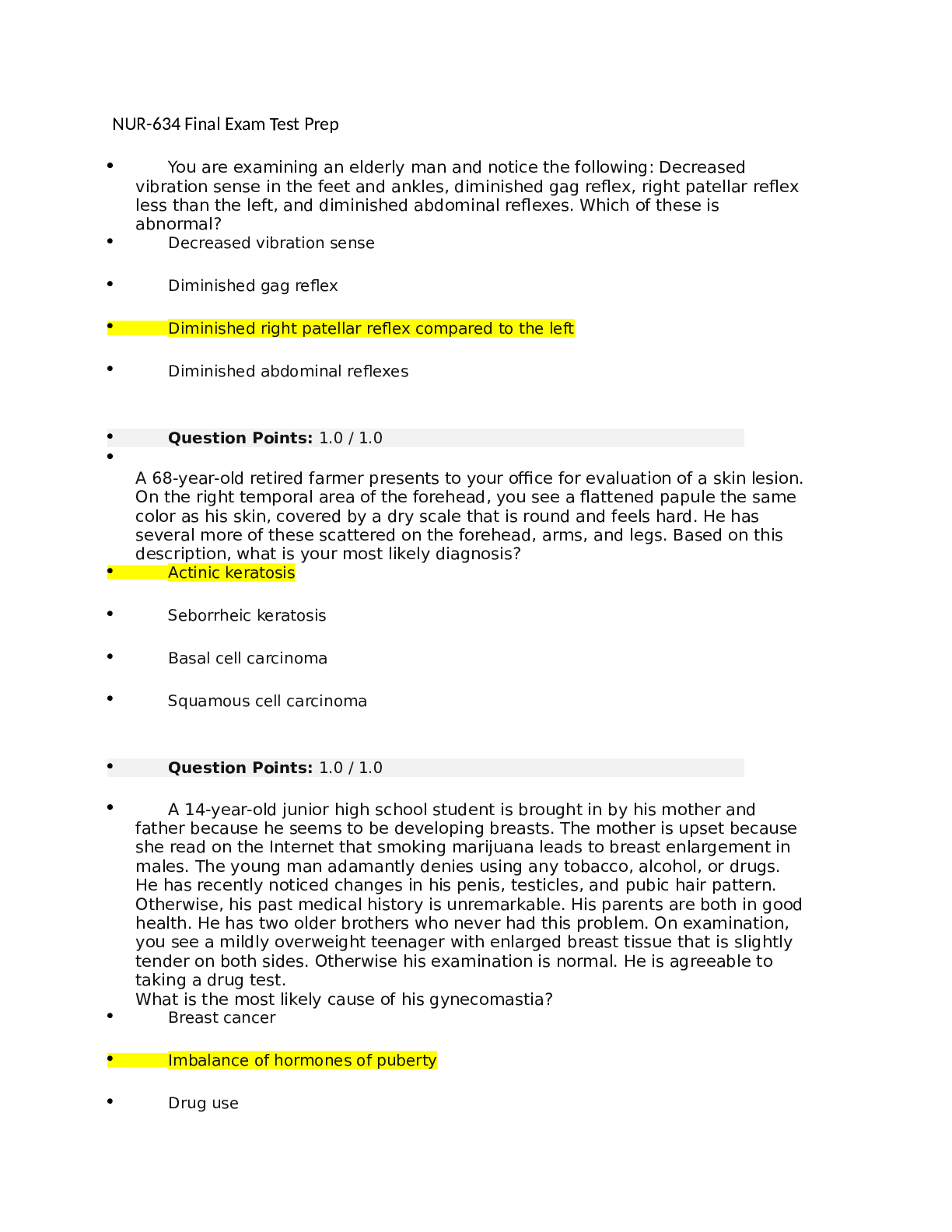
Buy this document to get the full access instantly
Instant Download Access after purchase
Add to cartInstant download
Reviews( 0 )
Document information
Connected school, study & course
About the document
Uploaded On
Sep 13, 2021
Number of pages
37
Written in
Additional information
This document has been written for:
Uploaded
Sep 13, 2021
Downloads
0
Views
33

 (1).png)

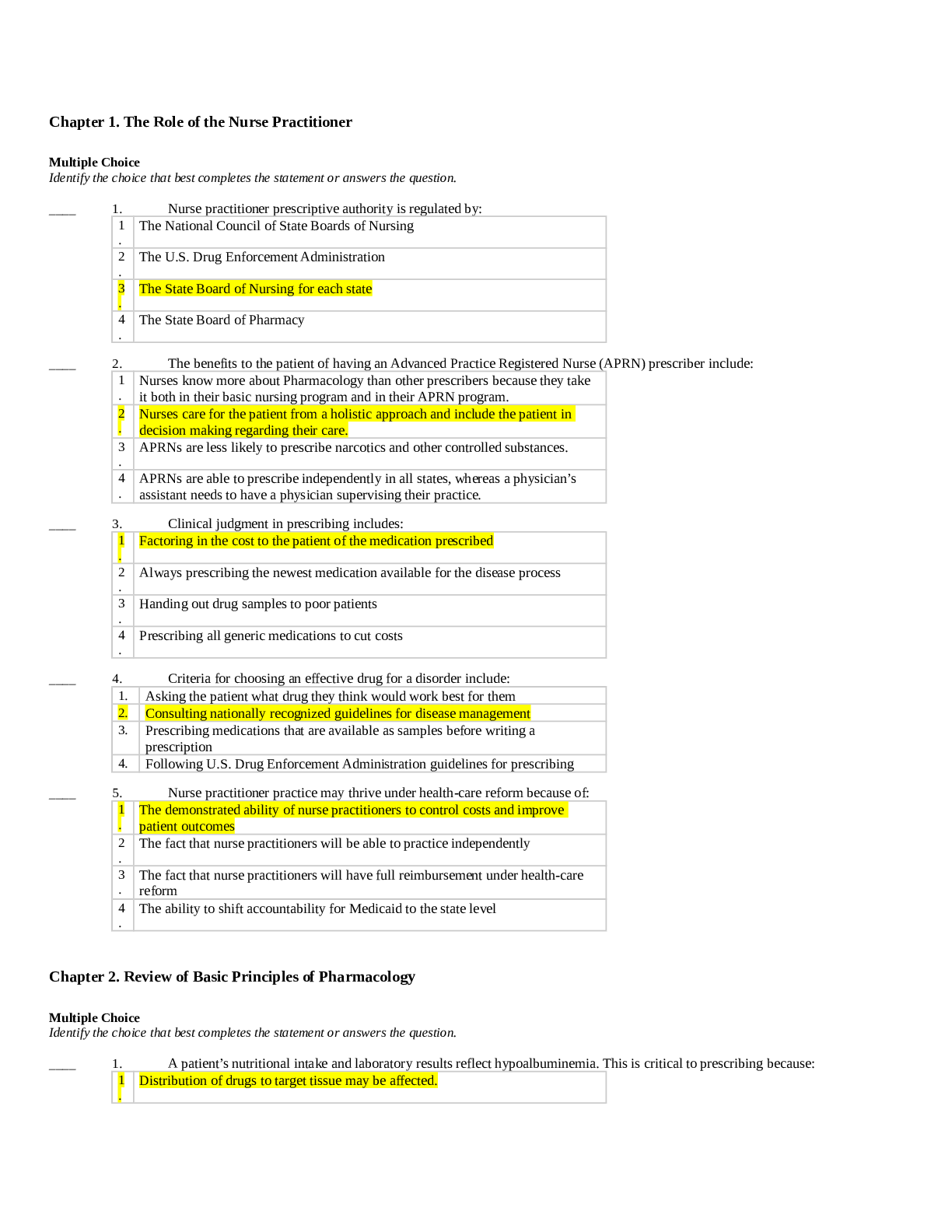

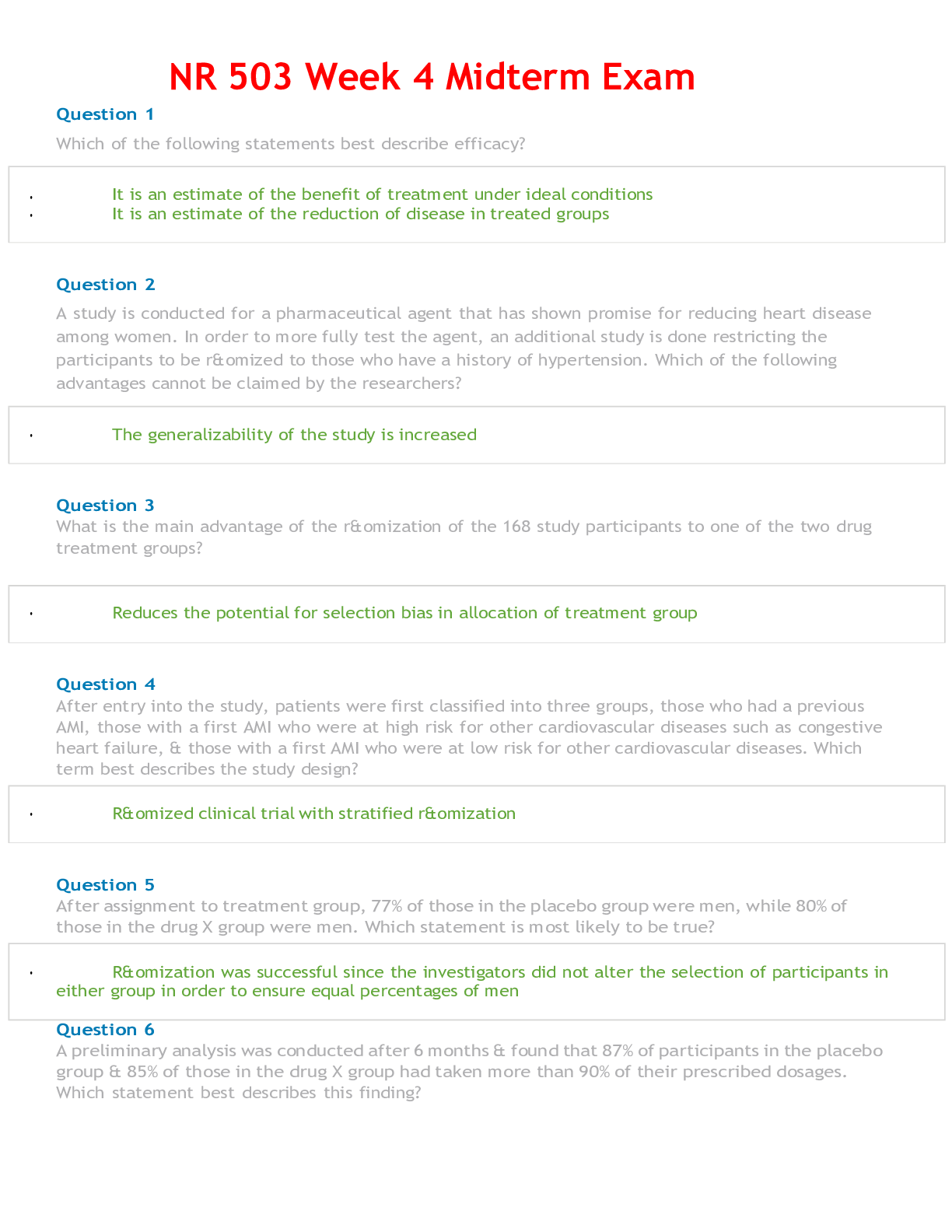

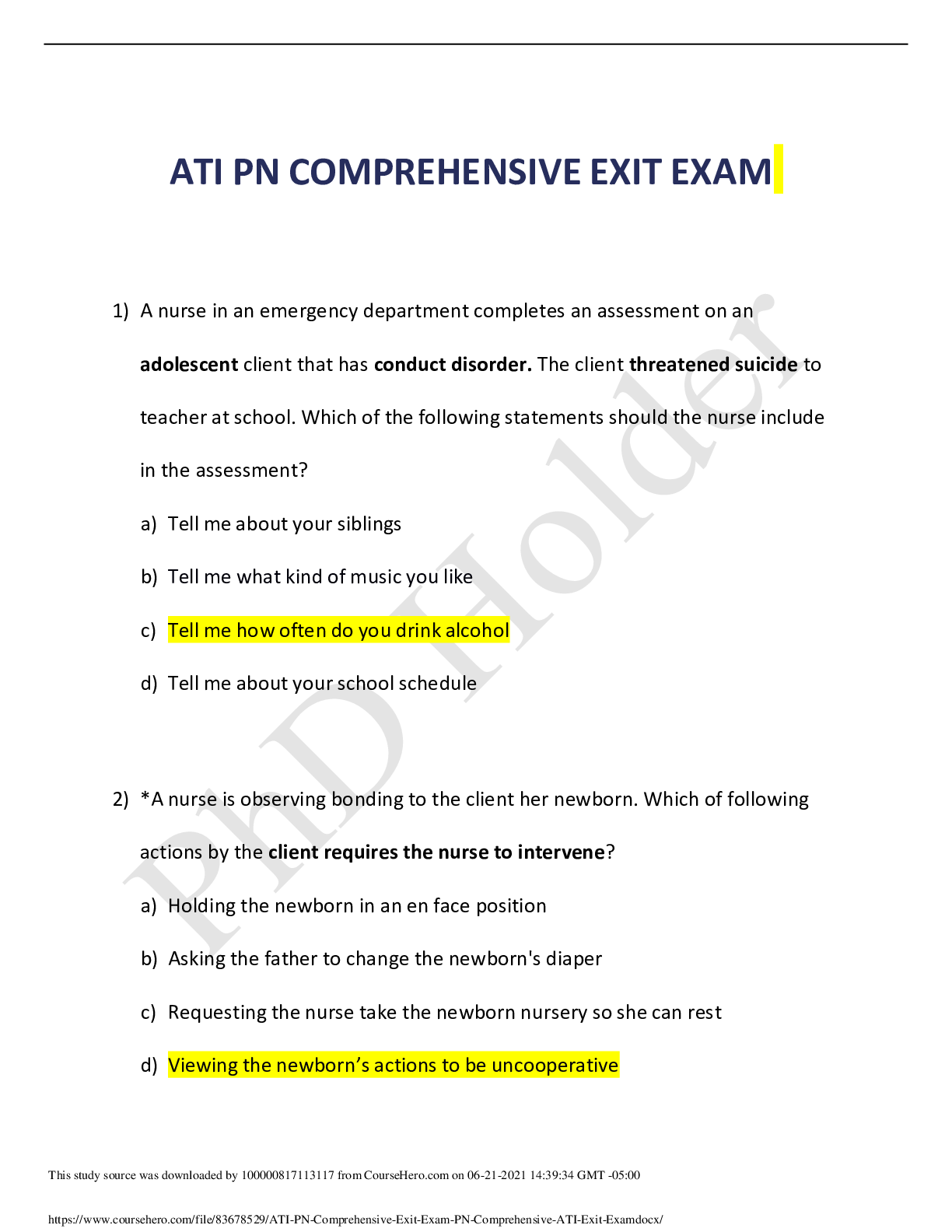
.png)
